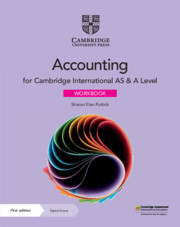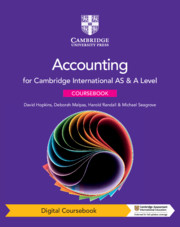Our Cambridge International AS & A Level Accounting Workbook is filled with a wide variety activities that offer extra practice opportunities beyond the coursebook. Ideal for skills development, the scaffolded exam-style activities enable students to practise what they have learnt from the coursebook.
Features
- Key skills and scaffolded exam-style activities enable students to put into practice what they have learnt from the coursebook
- Worked examples provide step-by-step guidance for developing knowledge and skills
- Tip boxes and defined key terms provide extra language support
- ‘Improve this answer’ activity helps students develop their evaluation skills and understand what a ‘good’ answer looks like
Table of Contents
- How to use this book (provided by Cambridge University Press)
- Introduction
- Introducing command words
- Part I The accounting system
- 1 Double-entry bookkeeping: Cash transactions
- 2 Double-entry bookkeeping: Credit transactions
- 3 Books of prime entry
- 4 Balancing accounts
- 5 The classification of accounts and division of the ledger
- 6 The trial balance
- Part II Financial accounting
- 7 The statement of profit or loss for sole traders
- 8 The statement of financial position for sole traders
- 9 Accounting concepts
- 10 Accruals and prepayments (the matching concept)
- 11 Accounting for the depreciation of non-current assets
- 12 Irrecoverable and doubtful debts
- 13 Bank reconciliation statements
- 14 Control accounts
- 15 Correction of errors
- 16 Incomplete records
- 17 Incomplete records: Further considerations
- 18 Partnership accounts
- 19 Partnership changes
- 20 Manufacturing accounts
- 21 An introduction to limited company accounts
- 22 Limited companies: Further considerations
- 23 Non-profit making organisations (clubs and societies)
- 24 Statement of cash flows
- 25 Auditing and stewardship
- 26 International Accounting Standards
- 27 Computerised accounting systems
- 28 Business acquisition and merger
- 29 Ethical considerations
- 30 Accounting information for stakeholders
- 31 Analysis and communication of accounting information
- Part III: Cost and management accounting
- 32 Costing of materials, labour and overheads
- 33 Absorption costing
- 34 Unit, job and batch costing
- 35 Marginal costing
- 36 Activity-based costing
- 37 Budgeting and budgetary control
- 38 Standard costing
- 39 Investment appraisal.
Advice on useful tools
Advice on useful tools, activities and timetabling from teachers experiencing school closures.
Cambridge GO
All our supporting resources have now moved to Cambridge GO – the new home for your Cambridge digital content.
Listen to our podcast
Listen to our podcast to discover teaching inspiration & advice from leading educational thinkers.







